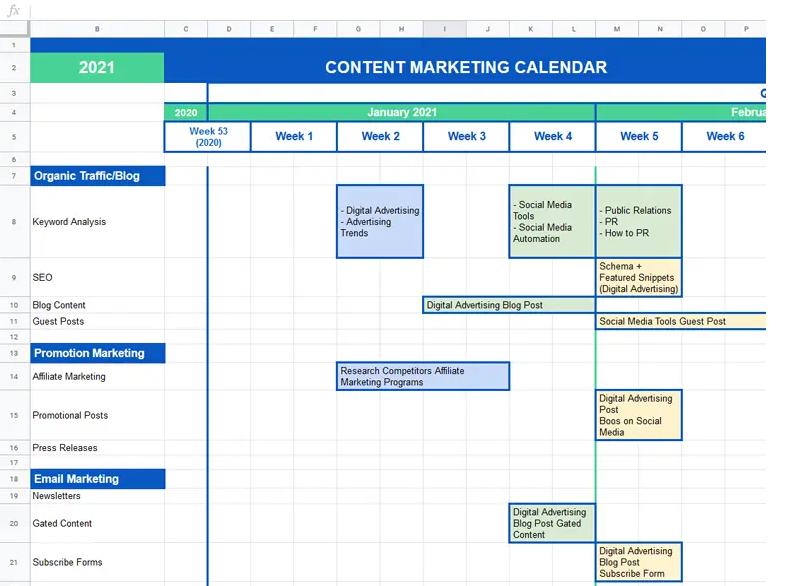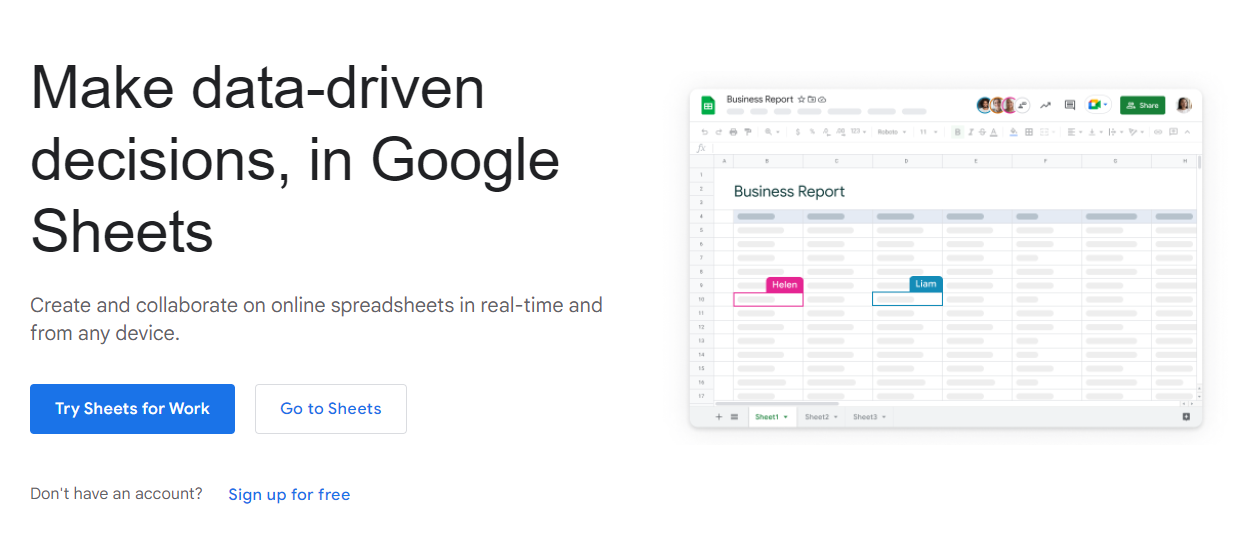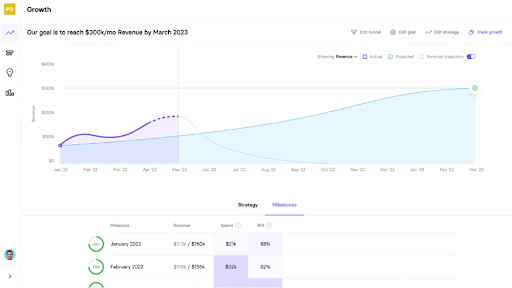A successful marketing campaign is like a great Broadway show—it doesn’t happen by accident. Brands need to keep their whole team aligned, meet pressing deadlines, and perform quality control on all pieces of collateral, long before the curtain opens.
And contrary to popular belief, there’s not much luck involved at all.
Preparing for a great marketing campaign involves meticulous planning, attention to detail, and sometimes a bit of forecasting. You can’t stop unexpected deadlines or roadblocks from impacting your marketing activities, but you can create a detailed marketing calendar that sets achievable goals, tactics, and solutions for each campaign you accomplish.
Let’s take a closer look at the nuts and bolts of building an ecommerce marketing calendar, as well as some tools that may help to simplify the process.

Start selling online now with Shopify



What is a marketing calendar?

A document that houses detailed plans for specific marketing campaigns is known as a marketing calendar. This spreadsheet, database, or table is used to track the activities, deadlines, and goals that will be used on a project within a set period of time. For example, some marketing calendars plan out campaigns over the course of a full year, while others detail quarterly, monthly, or weekly cycles.
Ultimately, the goal of a marketing calendar is to visually display the details of upcoming marketing projects and their place in a company’s timeline.
How to set goals for a marketing calendar
Marketing calendars should never be built in a vacuum. Clear objectives should undergird every campaign you add, alongside detailed goals and KPIs that determine its overall success. In other words, goals are needed to help marketers understand what their campaigns should accomplish—and how they get from point A to point B in the most effective way possible.
However, determining goals for campaigns on your calendar may not always be straightforward. It’s worth knowing what you want upfront to guard against unexpected pitfalls, which can help you stay more agile in the marketplace. Above all, you’ll want objectives that are SMART: specific, measurable, achievable, relevant, and timely.
Start by asking some exploratory questions:
- Which campaigns have hard deadlines, and which do not?
- Where can you build some intentional flex space in the timeline?
- How can you create intentional cohesion between each goal?
Keep in mind that goals are not the same as tactics. Once you know exactly what kind of results you want from each campaign (goals), you can start laying out stepping stones that get you there faster (tactics).
How do you build a marketing calendar?

Now that you have your goals, it’s time to actually build the structure of your marketing calendar. Let’s take a closer look at the five steps needed to create a working system.
1. Set your time frame
How far out do you intend to track your marketing campaigns? Do you need separate calendars for individual time periods? The sooner you know the answers to these questions, the sooner you can start building spreadsheets that work as intended.
Most businesses start planning their marketing campaigns in three intervals:
- Planning for the month allows you to quickly respond to changing needs while still being ahead of the game.
- Choosing to plan per quarter lets you adjust to any changing budgetary restrictions while planning out larger marketing campaigns.
- A one-year calendar may put you a huge step ahead of the competition, but keep in mind that these long-term plans may also be more inflexible.
Be sure to discuss your expectations for time frames with all parties in the planning process, including your sales team and outside partnerships.
2. Choose your channels of choice

Not every social channel or activity needs to be added to your marketing calendar. Thoughtfully consider the platforms that need planning before giving them a place on your board. Fewer channels will give you more space to break down activities by category, while adding more may provide slightly better visibility.
Find a happy balance for your master marketing calendar, or create separate calendars for individual marketing channels. Remember: the goal is accessibility, not needless complicated information. Adjust your strategy accordingly.
3. Create long-term flexibility
Opportunities arise in the strangest places—and oftentimes at the last minute. As you design your marketing calendar, be sure to leave space for some much-needed flexibility. Create a plan for when things don’t go as expected, or develop a system of checks and balances:
- Have a fallback plan for larger campaigns
- Give deadlines enough space to make changes
- Have supplementary content ready to go (just in case)
As you spend more time on your marketing calendars, you’ll start to catch inflexibility before it negatively affects your final outcomes. In either case, building a flexible calendar is a surefire way to avoid falling short of your goals.
4. Pick your campaign types
Not all campaigns were created equal. As you plan, you’ll want to break down your marketing activities into individual campaign types.
For most businesses, this largely includes one of five vertices:
- Promotions: any coupon, sale, or discount brought to the audience’s attention
- Content: releasing content into the world that promotes your brand
- Contest: pushing for new followers, leads, or viral attention via giveaways
- Product: launching new goods or services into the marketplace
- Awareness: making audiences aware of your brand, products, or values
Remember that the goal of a marketing campaign is to create a series of multimedia messages surrounding a single topic. Make sure that your marketing objectives are all mapped around the same goal and campaign, providing touches of your brand voice in an overarching story.
5. Assign levels of importance
Not all of your marketing activities share the same level of importance. Some campaigns, content, and product launches will take more of a back seat, while other top-line activities have stricter deadlines and outcomes more critical to the success of your brand.
Assigning levels of importance to your content can keep your team on the same page and ultimately support the completion of tasks and duties before their deadlines. This can be done by color-coding or numbering entries using a tier-based system.
Today, most marketers divide their campaigns across one of three levels:
- Tier 1: Campaigns that are absolutely essential to your brand are placed on the highest tier of importance. Anything that involves new product launches, large promotions, or big events will likely end up on this list.
- Tier 2: This content likely takes a week or more of planning, and may involve marketing reports, brand awareness campaigns, and more. The rule of thumb? Mid-tier content will require some intracompany collaboration.
- Tier 3: These marketing campaigns may require little or no time to execute. Common examples of Tier 3 activities include posting branded photos or publishing seasonal content.
Not enough levels here to accommodate your workflow? Feel free to add forth or fifth tiers of importance if it fits your business better.
Best tools for building ecommerce marketing calendars
Pick a marketing calendar tech stack that fits all of your objectives. You can swing for the fences with a detailed or enterprise-grade tool, or keep it simple with platforms that supply all the basics. The choice is up to you!
With that said, here are some tools to help get you started:
Google Sheets

If simplicity is what you’re looking for, Google Sheets is a great place to start. Similar to Microsoft Excel, this powerful tool allows multiple users to collaborate in the same document. Add charts, change data, and build separate sheets for different types of marketing campaigns.
While Google Sheets is free for personal use, access will require a business plan ($6 per month per user) for larger teams.
TrueNorth

Larger ecommerce companies often rely on enterprise-grade software such as TrueNorth. This complex platform lets you create detailed marketing calendars, complete with visual charts, timelines, and other built-in features. There are also several integrations that speed up the data entry process, including Google Analytics.
Keep in mind that this is the most expensive tool on the list. After a 14-day free trial, TrueNorth starts billing at $99 per month.
Trello

Trello’s visual organizer works well for early stage marketing calendars. The platform offers multiple templates (including marketing calendars) to start things off on the right foot. Create individual campaigns under each card, or designate separate columns to house individual tasks. These cards may be viewed strictly as columns or within a calendar format.
Note that Trello offers free plans for personal boards as well as paid plans for more complex tasks. Its flexible pricing plans scale without much trouble, which may be helpful to newer brands.
Leverage your resources with flexible storytelling
Building a marketing calendar for your ecommerce store is only half the battle. Now you need to start adding valuable, meaningful marketing objectives that meet business needs and customer expectations. Ask yourself: “Is this campaign going to give us the outcomes we want?” “Are these pieces of collateral telling our story effectively?” Gather all necessary resources to construct a system that works best for you.
Remember: your marketing calendar must be both flexible and insightful, bending with changing events, trends, and delays. It might be a solid foundation, but it should never get in the way of change or progress. Be willing to adapt your approach as time goes on, and hunt for new tech or tips to refine your calendar even further.
So set your deadlines. Add detailed notes and objectives. Above all, maintain consistency with your projects and campaigns. At the end of the day, your marketing calendar will be a powerful and influential part of your marketing toolkit—you just have to get it started

Start selling online now with Shopify



Want to learn more?
- How to Create a Killer Social Media Marketing Plan
- The Ultimate Guide to Brand Strategy
- How to Harness the Awesome Power of Customer Relations
- 17 Seriously Inspiring Mission and Vision Statements





